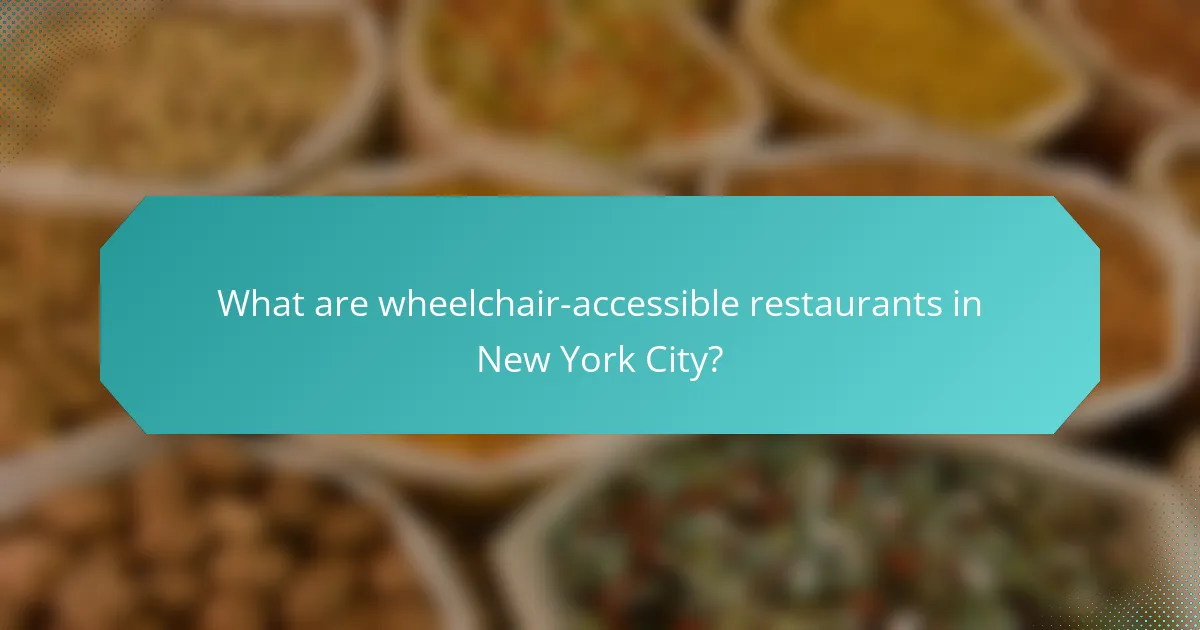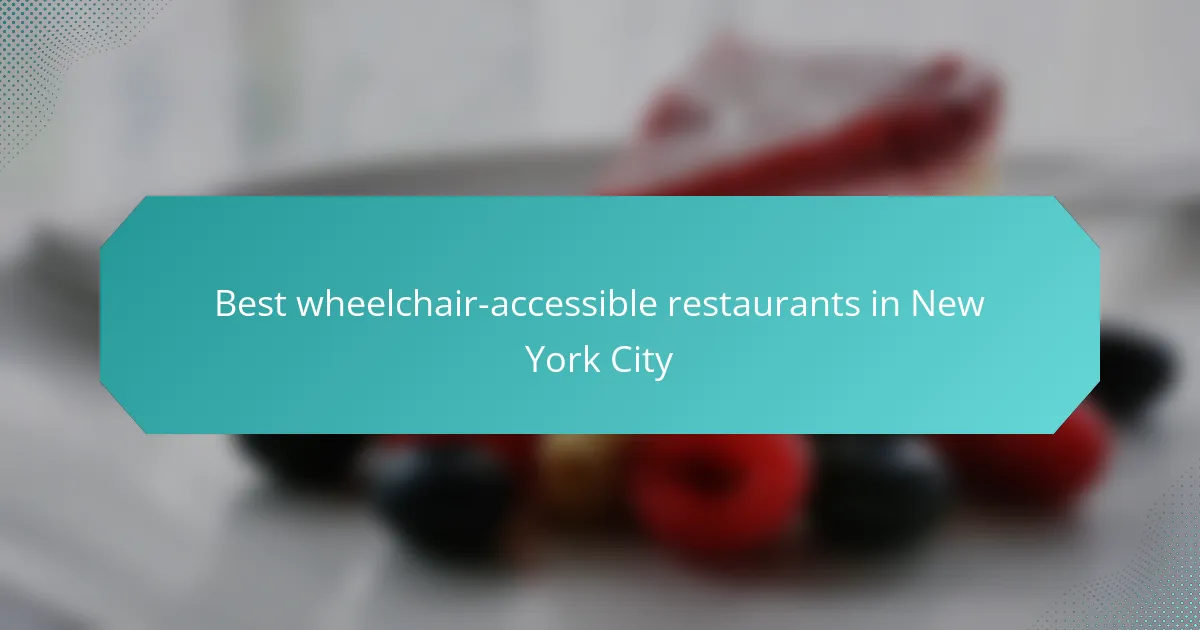The article focuses on wheelchair-accessible restaurants in New York City, highlighting popular establishments such as Carmine’s, The Smith, and Shake Shack. These restaurants are equipped with ramps, wide doorways, and accessible restrooms, ensuring comfort for all guests. Key features include spacious layouts and ADA compliance, making dining experiences enjoyable for individuals with mobility challenges. Additional options like Blue Smoke and Ellen’s Stardust Diner further enhance the accessible dining scene. The article emphasizes the importance of verifying accessibility features in advance to ensure a smooth dining experience.

What are wheelchair-accessible restaurants in New York City?
Wheelchair-accessible restaurants in New York City include popular options like Carmine’s, The Smith, and Shake Shack. These establishments feature ramps, wide doorways, and accessible restrooms. Carmine’s offers Italian cuisine and is known for its spacious layout. The Smith provides American fare and has multiple locations with ADA compliance. Shake Shack is a fast-casual chain with accessible seating and ordering areas. Many of these restaurants are listed on platforms like Yelp and the OpenTable website, highlighting their accessibility features.
How do wheelchair-accessible restaurants differ from regular restaurants?
Wheelchair-accessible restaurants differ from regular restaurants primarily in their design and facilities. These establishments feature ramps, wider doorways, and accessible restrooms. They often have designated parking spaces for individuals with disabilities. Additionally, the seating arrangements are typically designed to accommodate wheelchairs. Staff training may include awareness of accessibility needs. Compliance with the Americans with Disabilities Act (ADA) is a key factor for these restaurants. Regular restaurants may not meet these specific accessibility standards. Data shows that about 1 in 5 Americans has a disability, highlighting the importance of such accommodations.
What features make a restaurant wheelchair-accessible?
A wheelchair-accessible restaurant includes features that facilitate easy access for individuals using wheelchairs. These features typically include ramps at entrances with a slope no steeper than 1:12. Doorways should be at least 32 inches wide to accommodate wheelchairs. Interior pathways must be clear and at least 36 inches wide for maneuverability. Accessible restrooms should have grab bars and enough space for wheelchair turning. Tables should have a height of 28 to 34 inches with knee clearance for wheelchair users. Staff training on assisting individuals with disabilities is also essential. Compliance with the Americans with Disabilities Act (ADA) ensures these features are met.
Why is accessibility important in the dining experience?
Accessibility is important in the dining experience because it ensures that all individuals can enjoy meals without barriers. This includes people with disabilities, the elderly, and families with young children. Accessible dining promotes inclusivity and equal opportunity. According to the Americans with Disabilities Act (ADA), restaurants must provide accessible facilities. This includes wheelchair ramps, accessible restrooms, and appropriate seating arrangements. Inaccessible dining spaces can lead to exclusion and frustration. Statistics show that over 61 million adults in the U.S. live with a disability. Providing accessible dining options can increase customer satisfaction and loyalty.
What criteria should be considered when evaluating wheelchair-accessible restaurants?
Criteria for evaluating wheelchair-accessible restaurants include entrance accessibility, restroom facilities, and seating arrangements. Entrance accessibility should feature ramps or automatic doors. Restroom facilities must be spacious enough for maneuverability. Seating arrangements should allow for easy navigation and space for wheelchairs. Staff training on assisting individuals with disabilities is also essential. Clear pathways and signage enhance overall accessibility. Additionally, consider the availability of accessible parking nearby. Compliance with the Americans with Disabilities Act (ADA) is a critical standard for evaluation.
How does location impact accessibility in New York City?
Location significantly impacts accessibility in New York City. Areas with high population density often have better infrastructure for accessibility. For instance, neighborhoods like Manhattan have more wheelchair-accessible public transportation options. In contrast, outer boroughs may lack similar resources. Proximity to major attractions also influences accessibility. Restaurants near subway stations typically offer easier access. Additionally, sidewalk conditions vary by location, affecting mobility. According to the NYC Department of Transportation, 25% of streets are compliant with accessibility standards. This discrepancy highlights the importance of location in determining access for wheelchair users.
What role do customer reviews play in assessing accessibility?
Customer reviews are crucial in assessing accessibility for wheelchair-accessible restaurants. They provide firsthand accounts of experiences related to access features. Reviews often highlight specific attributes like ramps, door widths, and restroom facilities. Users share insights on the ease of navigation within the restaurant. Feedback can indicate whether staff is accommodating to guests with disabilities. Positive reviews may affirm a restaurant’s commitment to accessibility. Conversely, negative reviews can reveal shortcomings that might deter potential customers. According to a study by the National Center for Accessible Media, consumer feedback significantly influences public perception of accessibility standards.

What are the best wheelchair-accessible restaurants in New York City?
Some of the best wheelchair-accessible restaurants in New York City include Blue Smoke, which offers ample space and accessible restrooms. Another option is The Smith, known for its flat entry and spacious layout. Additionally, Carmine’s provides accessible seating and a welcoming environment. For a unique experience, try Ellen’s Stardust Diner, which features wheelchair access and entertainment. These restaurants prioritize accessibility, ensuring a comfortable dining experience for all guests.
Which neighborhoods in New York City have the best options?
Manhattan and Brooklyn have the best options for wheelchair-accessible restaurants in New York City. Manhattan offers neighborhoods like the Upper West Side and Greenwich Village. These areas boast numerous restaurants with accessible entrances and facilities. Brooklyn’s Williamsburg and Park Slope neighborhoods also feature a variety of accessible dining options. These neighborhoods are known for their vibrant food scenes. Many establishments comply with ADA standards. Public transportation in these areas is also wheelchair-friendly, enhancing accessibility.
What are some highly-rated wheelchair-accessible restaurants in Manhattan?
Some highly-rated wheelchair-accessible restaurants in Manhattan include The Smith, which offers American cuisine and has accessible entrances. Another option is Carmine’s, known for its Italian dishes and spacious seating. Additionally, Blue Smoke provides barbecue and has wheelchair-friendly facilities. The Modern, located at the Museum of Modern Art, features contemporary American dining with accessibility accommodations. Lastly, Shake Shack is popular for its burgers and is fully accessible. These restaurants have received positive reviews for their accessibility and dining experiences.
Are there notable wheelchair-accessible restaurants in Brooklyn?
Yes, there are notable wheelchair-accessible restaurants in Brooklyn. Many restaurants in Brooklyn prioritize accessibility for all patrons. Examples include Roberta’s, known for its pizza and spacious layout. Another option is The River Café, which offers stunning views and accessible facilities. Additionally, Peter Luger Steak House is also wheelchair-friendly. These establishments comply with accessibility standards, ensuring a comfortable dining experience.
What types of cuisine are available in wheelchair-accessible restaurants?
Wheelchair-accessible restaurants in New York City offer a variety of cuisines. Common types include Italian, Chinese, Mexican, and American. Many also feature Mediterranean and Indian options. These restaurants ensure that their facilities accommodate all diners. Accessibility includes ramps, wide doorways, and accessible restrooms. The diversity of cuisine reflects the city’s multicultural dining scene. This variety allows individuals with mobility challenges to enjoy different flavors and dishes.
How can diners find diverse dining options that are accessible?
Diners can find diverse dining options that are accessible by using online resources and apps. Websites like Yelp and Google Maps allow users to filter search results for wheelchair-accessible restaurants. These platforms often include user reviews that mention accessibility features. Additionally, social media groups focused on accessibility can provide recommendations. Local disability advocacy organizations may also publish lists of accessible dining venues. Many restaurants now display their accessibility options on their official websites. This information helps diners make informed choices about where to eat.
What are popular dishes at wheelchair-accessible restaurants?
Popular dishes at wheelchair-accessible restaurants include classic American fare, Italian cuisine, and Asian-inspired meals. Many diners enjoy burgers, which are a staple at numerous locations. Pasta dishes, such as spaghetti and meatballs, are also frequently ordered. Sushi rolls are popular in Asian restaurants, providing a fresh option. Salads and healthy bowls offer lighter choices for health-conscious patrons. Pizza is a favorite, available in various styles and toppings. Desserts like cheesecake and chocolate mousse round out the meal options. These dishes cater to diverse tastes and dietary preferences, making them popular among restaurant-goers.

How can you ensure a great dining experience at wheelchair-accessible restaurants?
To ensure a great dining experience at wheelchair-accessible restaurants, confirm the restaurant’s accessibility features in advance. Check if the entrance has ramps and wide doorways. Verify the availability of accessible restrooms. Look for tables with enough space for wheelchair maneuverability. Review online menus for dietary preferences or restrictions. Consider making a reservation to ensure a smooth experience. According to the Americans with Disabilities Act, establishments must provide accessible facilities. This law supports the importance of accessibility in dining environments.
What tips can help you choose the right restaurant?
Consider the restaurant’s accessibility features. Look for ramps, wide doorways, and accessible restrooms. Check online reviews for feedback on the restaurant’s wheelchair accessibility. Research the menu to ensure it meets your dietary preferences. Evaluate the location for ease of access and parking availability. Confirm if the restaurant is busy during your visit time to avoid long waits. Ask about reservation policies for wheelchair users. Prioritize establishments known for excellent customer service.
How should you check accessibility features before your visit?
Check accessibility features by reviewing the restaurant’s website. Many establishments provide detailed information on their accessibility options. Look for sections specifically addressing accessibility or accommodations. You can also contact the restaurant directly via phone or email. Ask about wheelchair access, seating arrangements, and restroom facilities. Online reviews may also highlight accessibility experiences from previous customers. Use resources like accessibility guides or apps for additional information. These steps ensure a comfortable dining experience in wheelchair-accessible restaurants.
What should you do if you encounter accessibility issues at a restaurant?
Notify the restaurant staff immediately about the accessibility issue. Clearly explain the problem you are facing. Request assistance if needed, such as help with navigating the space. Document the issue if it persists, noting specific details. Consider providing feedback through a review or direct communication. Accessibility compliance is mandated by the Americans with Disabilities Act (ADA). This law requires restaurants to ensure access for individuals with disabilities. Reporting issues can help improve accessibility for future patrons.
What resources are available for finding wheelchair-accessible restaurants?
Online platforms like Yelp and Google Maps provide information on wheelchair-accessible restaurants. These platforms allow users to filter search results based on accessibility features. Websites such as AccessNow and WheelchairTravel also specialize in accessibility information. They offer user-generated reviews and ratings for restaurants based on their wheelchair accessibility. Local disability advocacy organizations may have lists or guides for accessible dining options. Social media groups focused on accessibility can also be valuable resources for recommendations.
How can online platforms assist in locating accessible dining options?
Online platforms can assist in locating accessible dining options by providing detailed information on restaurant accessibility features. These platforms often include user-generated reviews that highlight accessibility aspects. Features such as wheelchair ramps, accessible restrooms, and seating arrangements are commonly noted. Many platforms also allow users to filter search results based on accessibility criteria. This capability helps individuals quickly identify suitable dining venues. Additionally, some platforms partner with organizations focused on disability rights to ensure accuracy. Research indicates that 70% of users prefer platforms that provide accessibility information. This data underscores the importance of accessible dining information for consumers.
What local organizations support accessibility in restaurants?
Local organizations that support accessibility in restaurants include the Disability Rights Advocates and the National Council on Independent Living. Disability Rights Advocates works to ensure equal access to public accommodations, including restaurants. They provide resources and advocacy for individuals with disabilities. The National Council on Independent Living promotes the inclusion of people with disabilities in all aspects of community life. Their efforts include improving accessibility in dining establishments. These organizations often collaborate with local businesses to enhance compliance with accessibility standards.
What are some common misconceptions about wheelchair-accessible restaurants?
Many people believe that all wheelchair-accessible restaurants are fully accessible. However, this is often not the case. Some restaurants may have accessible entrances but lack accessible restrooms. Others might not accommodate wheelchair users in all seating areas. Furthermore, some establishments may have uneven surfaces or narrow pathways that hinder access. A survey by the National Council on Disability found that 90% of restaurants advertised as accessible still had barriers. This highlights the importance of checking specific accessibility features before visiting.
Why might some people think accessible restaurants compromise on quality?
Some people might think accessible restaurants compromise on quality due to perceptions of cost-cutting. Accessible features may lead to assumptions that restaurants prioritize compliance over culinary excellence. Additionally, there is a stereotype that accessible options are less innovative or lack variety. Some customers may have had negative experiences in the past, reinforcing this belief. Research indicates that accessibility can sometimes be seen as a trade-off for gourmet offerings. Furthermore, the focus on physical accessibility may overshadow the importance of food quality in customers’ minds.
How can awareness about accessibility improve dining experiences for everyone?
Awareness about accessibility can significantly enhance dining experiences for everyone. It ensures that restaurants cater to diverse needs, allowing individuals with disabilities to enjoy meals comfortably. Accessible features include ramps, wide doorways, and accessible restrooms. These improvements benefit all patrons by creating a more inclusive environment. Research shows that inclusive spaces can increase customer satisfaction. A study by the National Restaurant Association indicates that 90% of diners prefer restaurants that accommodate accessibility needs. This awareness fosters a positive dining atmosphere, encouraging repeat visits and broader customer bases. Ultimately, accessibility awareness leads to a better experience for all diners.
The main entity of this article is wheelchair-accessible restaurants in New York City. The article provides a comprehensive overview of various dining options that cater to individuals with mobility challenges, highlighting key features such as ramps, wide doorways, and accessible restrooms. It discusses the differences between wheelchair-accessible and regular restaurants, evaluates criteria for accessibility, and emphasizes the importance of inclusivity in the dining experience. Additionally, it identifies popular neighborhoods with accessible restaurants, shares tips for ensuring a great dining experience, and addresses common misconceptions about accessibility in the restaurant industry.
